Research on Carbon Emission Efficiency Space Relations and Network Structure of the Yellow River Basin City Cluster
Abstract
:1. Introduction
2. Materials and Methods
2.1. Study Area
2.2. Measurement of Carbon Emission Efficiency
2.3. Exploratory Spatial Data Analysis Method
2.4. Construction of the Carbon Emission Efficiency Network
2.4.1. Determination of Spatial Correlations of Regional Carbon Emission Efficiency
2.4.2. Exploring the Characteristics of Carbon Emission Efficiency Linkage Network Structure from the Perspective of Urban Agglomerations
- (1)
- Overall tightness of carbon emission efficiency network. The carbon emission efficiency correlation matrix calculated by the gravity model is a directed matrix, so the directed network density is to be explored and analyzed, and the calculation formula is:where: E is the density of the carbon efficiency network, L is the number of actual links between cities, and n is the number of node cities of the network species.
- (2)
- The overall centrality potential of the carbon emission efficiency network. In this paper, the degree centrality index reflecting the central potential is chosen to measure the degree of carbon emission network centrality and the expression of point-in (point-out) central potential.where: is the degree of point-in (point-out) centrality of the carbon efficiency network; is the maximum of the point-in (point-out) centrality of each city in the green network; is the point-in (point-out) centrality of the city . The denominator reaches the maximum value only when the network is a star-shaped network with n points.
- (3)
- It uses the total number of connected cities with the remaining cities after binarization to measure the resource control ability of the individual’s centrality metric. The centrality of a node city in the network is equal to the number of the remaining nodes connected to the node. This paper uses the degree of point-out (the degree to which the carbon emission efficiency of this city affects other cities) and the degree of point-in (the degree to which this city is affected by the carbon emission efficiency of other cities) to represent the “out” and “in” of the carbon emission efficiency relationship, respectively. The greater the node’s centrality, the more central it is in the overall network.
- (4)
- A cohesive subgroup is a method to divide the network nodes into small groups to study the relationship between subgroups. In this paper, the density matrix of each subgroup can be obtained by partitioning by the Concor method and then measuring the density of each subgroup separately. The three major urban clusters represent three blocks, respectively: compare the values in the density matrix of each subgroup in each block; the value more significant than the overall network density of the urban cluster is taken as 1, and the opposite scenario is 0, and finally, obtain the image matrix.
3. Results
3.1. Spatial and Temporal Spatial Variations of Carbon Emission Efficiency across City Clusters in the Yellow River Basin
3.1.1. Timing Characteristics of Efficient Carbon Emissions within Context of City Clusters
3.1.2. City Clusters: Relevant Spatial Aspects of Carbon Emission Efficiency
3.2. Network Evolution Features of the Yellow River Basin City Clusters’ Carbon Emission Efficiency Network
3.2.1. Preliminary Carving of Regional Carbon Emission Efficiency Correlation Net
3.2.2. Characteristics of Carbon Emission Efficiency Linkage Network Structure in the Perspective of City Clusters
Characteristics of the Overall Emission Efficiency Correlation Network Structure of Urban Agglomerations
- (1)
- For the examination of the overall stringency of carbon emission efficiency from 2006 to 2019, the number of linked nodes in the Shandong Peninsula city cluster is much higher than in other city clusters. In contrast to the highest figure, the real number of connections in the city cluster on the Shandong Peninsula city cluster is still modest. The maximum conceivable number of connections in the Shandong Peninsula city cluster is 240 (16 × 15); however, the greatest number of connections in the Shandong Peninsula city cluster during the research period was 77 (2019). Meanwhile, in each of the seven largest city clusters, some cities and the other cities have not formed any carbon emission efficiency association. In conclusion, the connections between carbon emission efficiency and the seven largest city clusters have much room for improvement. As shown in Figure 7, the network density of the Shandong Peninsula city cluster, the Guanzhong city cluster, and the Houbao city cluster increased between 2006 and 2019. The development trend of interregional synergy is favorable as the integration of urban clusters advances. The network densities of the remaining city clusters have all decreased to varying degrees, indicating that these four major city clusters do not pay sufficient attention to the improvement of carbon emission efficiency, and that factor flow between cities is insufficient, resulting in the stifling of the development of carbon emission efficiency improvement. The network density of all seven main city clusters is low, and the inter-city carbon emission efficiency connection is poor. The inter-city carbon emission efficiency linkage should be increased by modifying the network’s internal structure.
- (2)
- Global examination of the centrality of carbon emission efficiency. As seen in Table 2, with the exception of Ningxia along the Yellow River Group, the point-in central potentials of the other six major city clusters from 2006 to 2019 are greater than the point-out central potentials, indicating that the seven major city clusters have weaker outward radiation ability and stronger inward cohesion ability. The point-in and point-out central potentials of the three major urban agglomerations of the Hubao city cluster, the Jinzhong city cluster, and Ningxia along the Yellow River Group in 2019 are lower than those in 2006, with the Hubao city cluster and Jinzhong city cluster showing an apparent decreasing trend, indicating that the carbon emission efficiency improvement of the region tends to diversify and the differences between cities are diminishing. In 2019, the point-in and point-out central potentials of the Central Plains city cluster are greater than they were in 2006, suggesting that the cohesiveness and external radiation of this urban agglomeration have risen. Both the 2019 point-in central potentials for the Shandong Peninsula city cluster and the Guanzhong city cluster are less than those of 2006. Nonetheless, the point-out central potentials of 2019 are larger than those of 2006 to varying degrees, indicating that the cohesion of the two city clusters has deteriorated while the radiation power has grown progressively. The point-in central potential of the Lanxi city clusters in 2019 is greater than in 2006; however, the point-out central potential is lower in 2019 than in 2016. Thus, the radiating power of the carbon emission efficiency of the Lanxi city clusters is diminished, and the attraction of resources is enhanced, showing that certain places within the urban agglomeration generate a “siphon effect” on the surrounding areas as a result of their dominant position.
Emission Efficiency Correlation Network Structure Characteristics within City Clusters
- (1)
- Analysis of cities with exceptional carbon emission efficiency. We concentrate on highlighting towns with outstanding carbon emission efficiency. The carbon emission efficiency network centrality of the Shandong Peninsula city cluster, Central Plains city cluster, and Lanxi city cluster was assessed using Ucinet program. Due to the uneven number of cities within the Yellow River Basin’s three main city clusters, only the top two cities are featured. As shown in Table 3, the top two cities of the three largest city clusters in terms of point-in and point-out degrees are identical. The top two cities are the carbon emission efficiency epicenters. As the inhaling area for carbon emission efficiency development, the top two cities also take the function of dispersal for this emission efficiency increase. The 2006–2019 Shan-dong Peninsula city cluster Taian takes the lead as the network’s center for carbon emission efficiency, as the development level of carbon emission efficiency is strong and has dominated the Shan-dong Peninsula city cluster. From 2006 to 2019, the top two cities in the Central Plains city cluster in terms of point-in and point-out rankings changed dramatically. Luohe ranked first in terms of point-in rating for four years, whereas Kaifeng ranked first in terms of point-out ranking for four years. Baiyin and Dingxi were the top two cities in terms of point-in rating for the Lanxi city cluster from 2006 to 2019. Therefore, this indicates that Baiyin and Dingxi carbon emission efficiency has a considerable pull on the surrounding regions. Lanzhou is one of the top two cities in the Lanxi city cluster ranking from 2006 to 2019. This demonstrates that Lanzhou city has a greater impact on the neighboring regions.
- (2)
- Analysis of coherent subgroups of carbon emission efficiency. Ucinet software was used to conduct a block model analysis based on the correlation matrix of carbon emission efficiency for each city group in 2019. Figure 8 depicts the findings of the cohesive subgroups of the two main urban clusters, and Figure 9 shows the simplified “like matrix”. (1) Prominent subgroups: For instance, Zibo is the lone member of subgroup 2 of the Shandong Peninsula city cluster. Zibo is the industry leader in both input and output carbon emission efficiency and plays a crucial role. (2) The Bridge subgroup, such as Central plains city cluster 1 subgroup. As a representative, Shangqiu has a two-way communication connection with the main subgroup and is closely linked to Kaifeng and Jiaozuo. (3) For the net input subgroup: Pingdingshan, due to its proximity to the carbon emission efficiency subgroup, with Zhengzhou as the core. This subcluster’s resource components are more appealing to the subclusters that surround it. Their linkages are thus unidirectional, and the net output sub-group input impact is less than the output effect. In conclusion, the aforementioned subgroups have distinct tasks and labor divisions. Consequently, the network architectures of the two main urban clusters are notably different, although the characteristics of intra-city cluster links are identical to those of the overall linkages.
4. Conclusions, Recommendations, and Discussion
4.1. Conclusions
4.2. Recommendations
- (1)
- Taking into account the differences in carbon emission efficiency within the Basin, we select the most appropriate growth strategy based on local circumstances. The Basin should continue to strengthen the regional economic foundation, increase research and development of low-carbon technologies, enhance low-carbon innovation capacity, and promote the effective diffusion of low-carbon technologies based on the current development advantages and characteristics. For instance, using strategies such as “transport the natural gas from the West to the East“ and “to transmit the electricity from the western areas to East China,” the green and low-carbon energy transition may be successfully supported in the upper reaches of the Yellow River Basin. At the same time, provinces with a higher carbon efficiency in the Basin may also spread their energy-saving technologies and green innovation skills to other areas, fostering an increase in the Basin’s carbon emission efficiency.
- (2)
- Concentrating on regions with poor carbon emission efficiency for the implementation of differentiated management methods, the region of low-value carbon emission efficiency must maximize the comparative benefits of resources and the environment. To avoid becoming a “refuge” for high-carbon businesses, we should also actively learn from advanced low-carbon technology and management expertise and accelerate the pace of industrial transformation and upgrading in the region. For instance, the industrial structure and reliance on coal and other resources of the Jinzhong city cluster are restrictions. With the advancement of low-carbon technology, we may therefore actively encourage the integration of scientific and technological elements into input variables and overcome the core contradiction of one coal and low-coal usage efficiency. By improving the structure of foreign trade, bringing sophisticated technology and management experience, and energetically promoting environmental sectors, the “Belt and Road” program can be used to increase the efficiency of carbon emissions.
- (3)
- Maximizing the beneficial geographic spillover impact and cooperation to advance carbon reduction and efficiency in the basin, the economic development advantages of high carbon emission efficiency zones should be maintained while the innovation and development of low carbon technologies and industries are strengthened. High carbon emission efficiency zones should also give proactive technical and skilled assistance for the development of low-value zones, hence expediting the flow and distribution of high carbon economic development factors between areas. Cooperation among Yellow River Basin provinces (regions) should be enhanced. For instance, the Shandong peninsula and the Houbao-Egyu city cluster are encouraged to share their development experience of balancing economic output and carbon emissions. Additionally, cooperatively investigate low-carbon development pathways should be cooperatively investigated in order to establish diverse and clean energy structures.
4.3. Discussion
Author Contributions
Funding
Institutional Review Board Statement
Informed Consent Statement
Data Availability Statement
Conflicts of Interest
Abbreviation
| Full of City Name | Abbreviation of City Name | Full of City Name | Abbreviation of City Name | Full of City Name | Abbreviation of City Name |
| Qingdao | QD | Pingdingshan | PD | Erdos | ER |
| Jinan | JN | Xinxiang | XX | Baotou | BT |
| Zibo | ZB | Jiaozuo | JZ | Yulin | YL |
| Zaozhuang | ZZ | hebei | HB | Lanzhou | LZ |
| Yantai | YT | Xuchang | XC | Xining | XN |
| Weifang | WF | Luohe | LH | Dingxi | DX |
| Jining | JIN | Shangqiu | SQ | Baiyin | BY |
| Linyi | LY | Zhoukou | ZK | Taiyuan | TY |
| Taian | TA | Jincheng | JV | Yangquan | YQ |
| Liaocheng | LC | Bozhou | BOZ | Changzhi | CZ |
| Heze | HZ | Xi’an | XA | Xinzhou | XZ |
| Dezhou | DZ | Tongchuan | TC | Jinzhong | JIZ |
| Binzhou | BZ | Baoji | BJ | Lvliang | LI |
| Dongying | DY | Xianyang | XY | Linfen | LF |
| Weihai | WH | Weinan | WN | Yinchuan | YC |
| Rizhao | RZ | Shangluo | SL | Shizuishan | SZS |
| Zhengzhou | ZHZ | Tianshui | TS | Wuzhong | WZ |
| Kaifeng | KF | huhehaote | HH | Zhongwei | ZW |
| Luoyang | LUY |
References
- Li, J.; Cheng, Z. Study on Total-Factor Carbon Emission Efficiency of China’s Manufacturing Industry When Considering Technology Heterogeneity. J. Clean. Prod. 2020, 260, 121021. [Google Scholar] [CrossRef]
- Zhao, Z.; Yan, Y.; Liu, J. The Approach to Achieve the “Double Carbon” Goal in Nine Provincesand Regions in the Yellow River Basin. J. Xi’an Jiaotong Univ. (Soc. Sci.) 2022. Available online: https://kns.cnki.net/kcms/detail/61.1329.c.20220727.1852.008.html (accessed on 28 July 2022).
- Du, H.; Wei, W.; Zhang, X.; Ji, X. Spatio-Temporal Evolution and Influencing Factors of Energy-Related Carbon Emissions in the Yellow River Basin: Based on the DMSP/OLS and NPP/VIIRS Nighttime Light Data. Geogr. Res. 2021, 7, 2051–2065. [Google Scholar] [CrossRef]
- Zhang, R.; Tai, H.; Cheng, K.; Zhu, Y.; Hou, J. Carbon Emission Efficiency Network Formation Mechanism and Spatial Correlation Complexity Analysis: Taking the Yangtze River Economic Belt as an Example. Sci. Total Environ. 2022, 841, 156719. [Google Scholar] [CrossRef]
- He, Y.-Y.; Wei, Z.-X.; Liu, G.-Q.; Zhou, P. Spatial Network Analysis of Carbon Emissions from the Electricity Sector in China. J. Clean. Prod. 2020, 262, 121193. [Google Scholar] [CrossRef]
- Jiang, Q.; Ma, X. Spillovers of Environmental Regulation on Carbon Emissions Network. Technol. Forecast. Soc. Chang. 2021, 169, 120825. [Google Scholar] [CrossRef]
- Liu, J.; Song, Q. Space Network Structure and Formation Mechanism of Green Innovation Efficiency of Tourism Industry in China. China Popul. Resour. Environ. 2018, 28, 127–137. [Google Scholar] [CrossRef]
- Shao, H.; Wang, Z. Spatial Network Structure of Transportation Carbon Emissions Efficiency in China and Its Influencing Factors. China Popul. Resour. Environ. 2021, 4, 32–41. [Google Scholar] [CrossRef]
- Gao, P.; Yue, S.; Chen, H. Carbon Emission Efficiency of China’s Industry Sectors: From the Perspective of Embodied Carbon Emissions. J. Clean. Prod. 2021, 283, 124655. [Google Scholar] [CrossRef]
- Xie, Z.; Wu, R.; Wang, S. How Technological Progress Affects the Carbon Emission Efficiency? Evidence from National Panel Quantile Regression. J. Clean. Prod. 2021, 307, 127133. [Google Scholar] [CrossRef]
- Liu, D.; Zhu, X.; Wang, Y. China’s Agricultural Green Total Factor Productivity Based on Carbon Emission: An Analysis of Evolution Trend and Influencing Factors. J. Clean. Prod. 2021, 278, 123692. [Google Scholar] [CrossRef]
- Zhang, C.; Chen, P. Industrialization, Urbanization, and Carbon Emission Efficiency of Yangtze River Economic Belt—Empirical Analysis Based on Stochastic Frontier Model. Environ. Sci. Pollut. Res. 2021, 28, 66914–66929. [Google Scholar] [CrossRef]
- Meng, F.; Su, B.; Thomson, E.; Zhou, D.; Zhou, P. Measuring China’s Regional Energy and Carbon Emission Efficiency with DEA Models: A Survey. Appl. Energy 2016, 183, 1–21. [Google Scholar] [CrossRef]
- Liu, B.; Tian, C.; Li, Y.; Song, H.; Ma, Z. Research on the Effects of Urbanization on Carbon Emissions Efficiency of Urban Agglomerations in China. J. Clean. Prod. 2018, 197, 1374–1381. [Google Scholar] [CrossRef]
- Xiao, H. CO2 Emission Reduction Potential in China from Combined Effects of Structural Adjustment of Economy and Efficiency Improvement. Resour. Conserv. Recycl. 2021, 174, 105760. [Google Scholar] [CrossRef]
- Zhang, M.; Liu, Y. Influence of Digital Finance and Green Technology Innovation on China’s Carbon Emission Efficiency: Empirical Analysis Based on Spatial Metrology. Sci. Total Environ. 2022, 838, 156463. [Google Scholar] [CrossRef]
- Pan, X.; Pan, X.; Li, C.; Song, J.; Zhang, J. Effects of China’s Environmental Policy on Carbon Emission Efficiency. Int. J. Clim. Change Strateg. Manag. 2019, 11, 326–340. [Google Scholar] [CrossRef]
- Zhou, Y.; Liu, W.; Lv, X.; Chen, X.; Shen, M. Investigating Interior Driving Factors and Cross-Industrial Linkages of Carbon Emission Efficiency in China’s Construction Industry: Based on Super-SBM DEA and GVAR Model. J. Clean. Prod. 2019, 241, 118322. [Google Scholar] [CrossRef]
- Du, Q.; Deng, Y.; Zhou, J.; Wu, J.; Pang, Q. Spatial Spillover Effect of Carbon Emission Efficiency in the Construction Industry of China. Environ. Sci. Pollut. Res. 2022, 29, 2466–2479. [Google Scholar] [CrossRef] [PubMed]
- Wang, R.; Feng, Y. Research on China’s Agricultural Carbon Emission Efficiency Evaluation and Regional Differentiation Based on DEA and Theil Models. Int. J. Environ. Sci. Technol. 2021, 18, 1453–1464. [Google Scholar] [CrossRef]
- Zhang, Y.-J.; Jiang, L.; Shi, W. Exploring the Growth-Adjusted Energy-Emission Efficiency of Transportation Industry in China. Energy Econ. 2020, 90, 104873. [Google Scholar] [CrossRef]
- Wang, F.; Gao, M.; Liu, J.; Fan, W. The Spatial Network Structure of China’s Regional Carbon Emissions and Its Network Effect. Energies 2018, 11, 2706. [Google Scholar] [CrossRef]
- Song, J.; Hu, X.; Wang, X.; Yuan, W.; Wang, T. The Spatial Characteristics of Embodied Carbon Emission Flow in Chinese Provinces: A Network-Based Perspective. Environ. Sci. Pollut. Res. 2022, 29, 34955–34973. [Google Scholar] [CrossRef] [PubMed]
- Chong, Z.; Pan, S. Understanding the Structure and Determinants of City Network through Intra-Firm Service Relationships: The Case of Guangdong-Hong Kong-Macao Greater Bay Area. Cities 2020, 103, 102738. [Google Scholar] [CrossRef]
- Bai, C.; Zhou, L.; Xia, M.; Feng, C. Analysis of the Spatial Association Network Structure of China’s Transportation Carbon Emissions and Its Driving Factors. J. Environ. Manag. 2020, 253, 109765. [Google Scholar] [CrossRef] [PubMed]
- Sun, W.; Huang, C. How Does Urbanization Affect Carbon Emission Efficiency? Evidence from China. J. Clean. Prod. 2020, 272, 122828. [Google Scholar] [CrossRef]
- Li, W.; Yang, G.; Li, X. Modeling the Evolutionary Nexus between Carbon Dioxide Emissions and Economic Growth. J. Clean. Prod. 2019, 215, 1191–1202. [Google Scholar] [CrossRef]
- Fan, J.; Wang, Y.; Wang, Y. High Quality Regional Development Research Based on Geographical Units: Discuss on the Difference in Development Conditions and Priorities of the Yellow River Basin Compared to the Yangtze River Basin. Econ. Geogr. 2020, 40, 1–11. [Google Scholar] [CrossRef]
- Gottmann, J. Megalopolis or the urbanization of the northeastern seaboard. Econ. Geogr. 1957, 33, 189–200. [Google Scholar] [CrossRef]
- Fang, C.; Yu, D. Urban Agglomeration: An Evolving Concept of an Emerging Phenomenon. Landsc. Urban Plan. 2017, 162, 126–136. [Google Scholar] [CrossRef]
- Tone, K. A Slacks-Based Measure of Efficiency in Data Envelopment Analysis. Eur. J. Oper. Res. 2001, 3, 498–509. [Google Scholar] [CrossRef] [Green Version]
- Andersen, P.; Petersen, N.C. A Procedure for Ranking Efficient Units in Data Envelopment Analysis. Manag. Sci. 1993, 39, 1261–1264. [Google Scholar] [CrossRef]
- Zhang, J.; Zeng, W.; Wang, J.; Yang, F.; Jiang, H. Regional Low-Carbon Economy Efficiency in China: Analysis Based on the Super-SBM Model with CO 2 Emissions. J. Clean. Prod. 2017, 163, 202–211. [Google Scholar] [CrossRef]
- Li, H.; Fang, K.; Yang, W.; Wang, D.; Hong, X. Regional Environmental Efficiency Evaluation in China: Analysis Based on the Super-SBM Model with Undesirable Outputs. Math. Comput. Model. 2013, 58, 1018–1031. [Google Scholar] [CrossRef]
- Zhang, J.; Wu, G.; Zhang, J. The Estimation of China’s Provincial Capital Stock: 1952–2000. Econ. Res. 2004, 10, 35–44. [Google Scholar]
- Wu, J.; Guo, Z. Research on the Convergence of Carbon Dioxide Emissions in China: A Continuous Dynamic Distribution Approach. Stat. Res. 2016, 33, 54–60. [Google Scholar] [CrossRef]
- Anselin, L. Local Indicators of Spatial Association-LISA. Geogr. Anal. 2010, 27, 93–115. [Google Scholar] [CrossRef]
- Shao, X.; Weng, Z.; Miao, Q.; Liu, Y. Evolution and Element Analysis of Regional Green Technology Innovation Output Network: Evidence from the Urban Agglomeration of the Yangtze River Economic Belt. Geogr. Geo-Inf. Sci. 2022, 38, 40–49. [Google Scholar]
- Liu, Q.; Hao, J. Regional Differences and Influencing Factors of Carbon Emission Efficiency in the Yangtze River Economic Belt. Sustainability 2022, 14, 4814. [Google Scholar] [CrossRef]

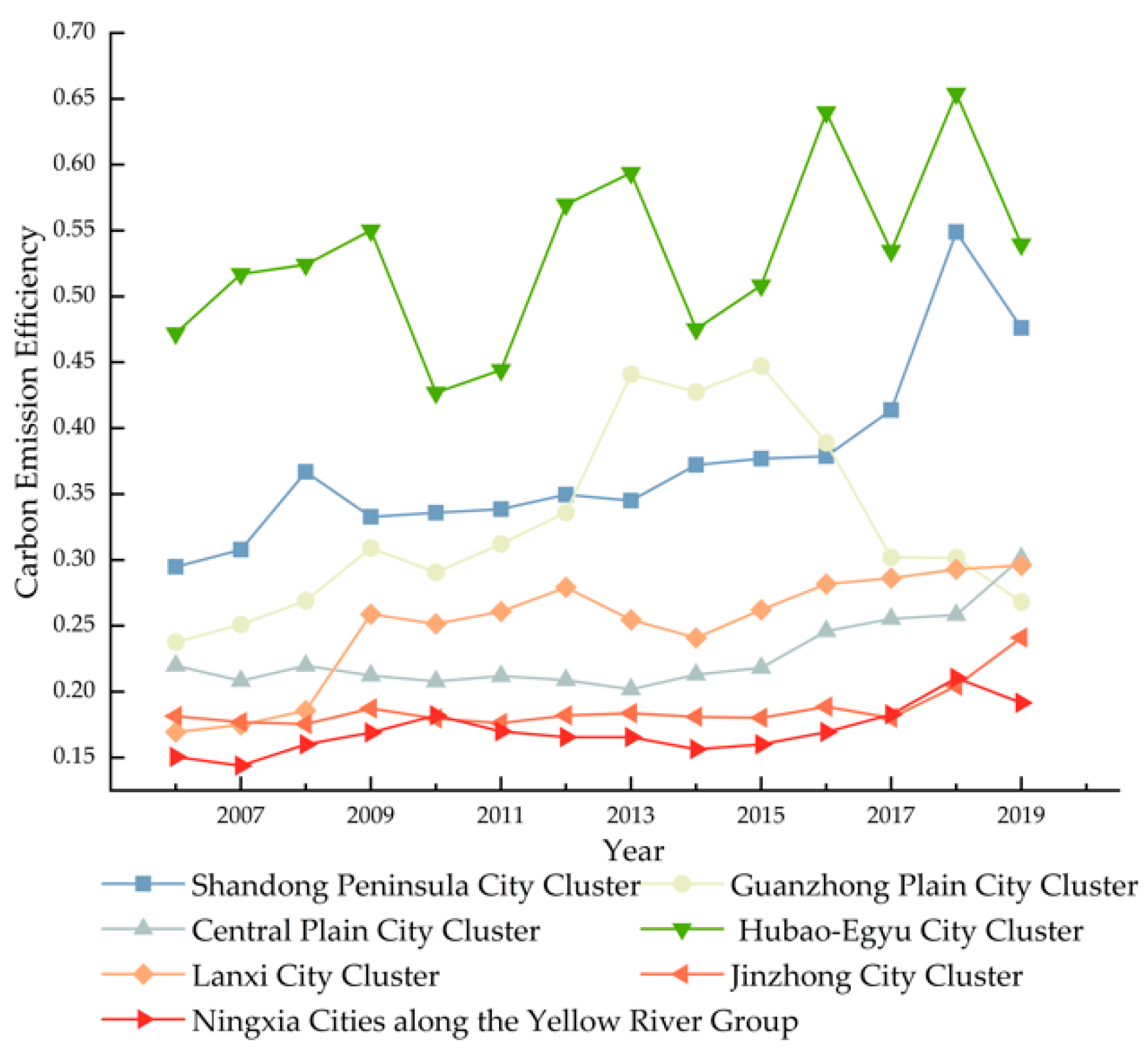
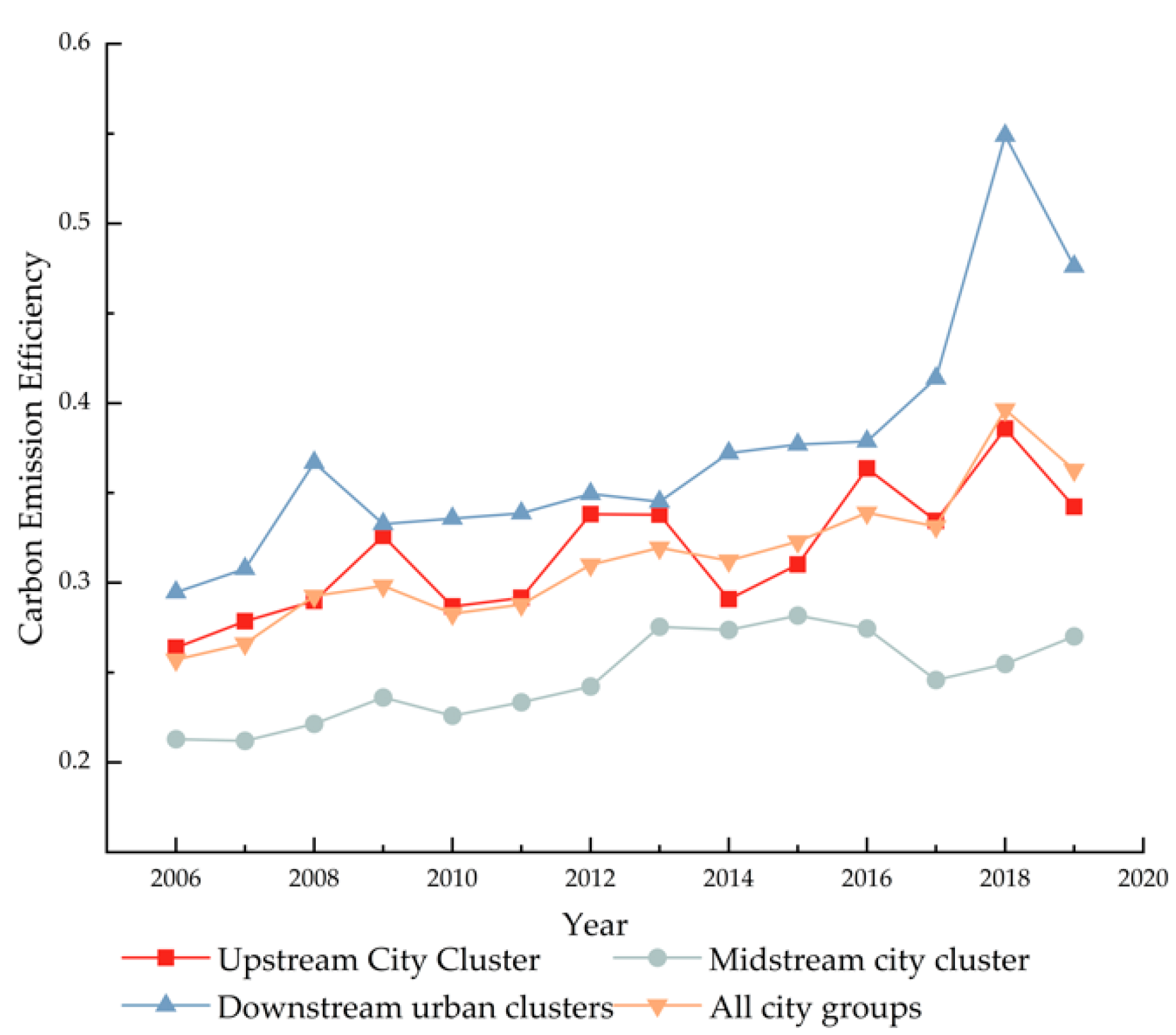
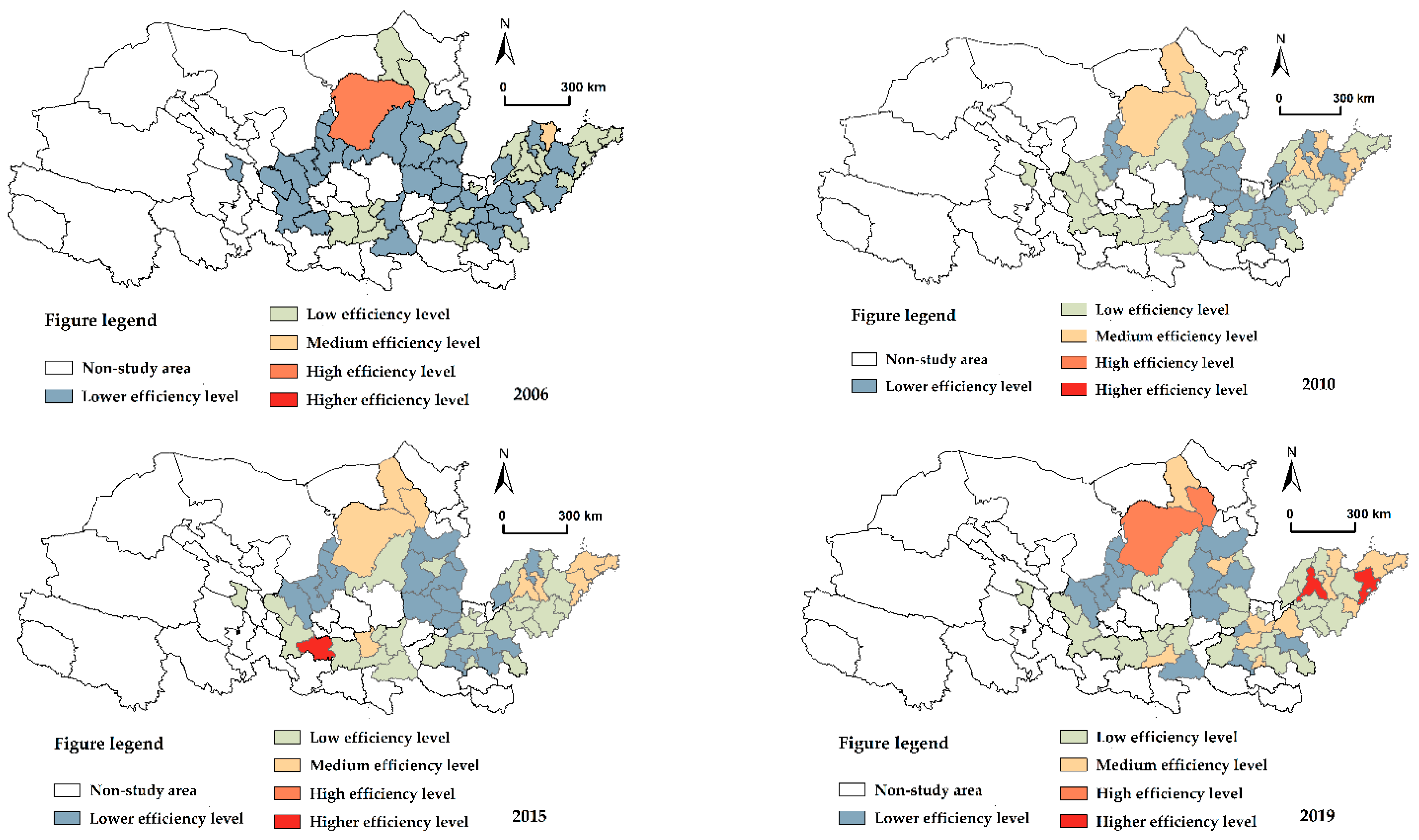
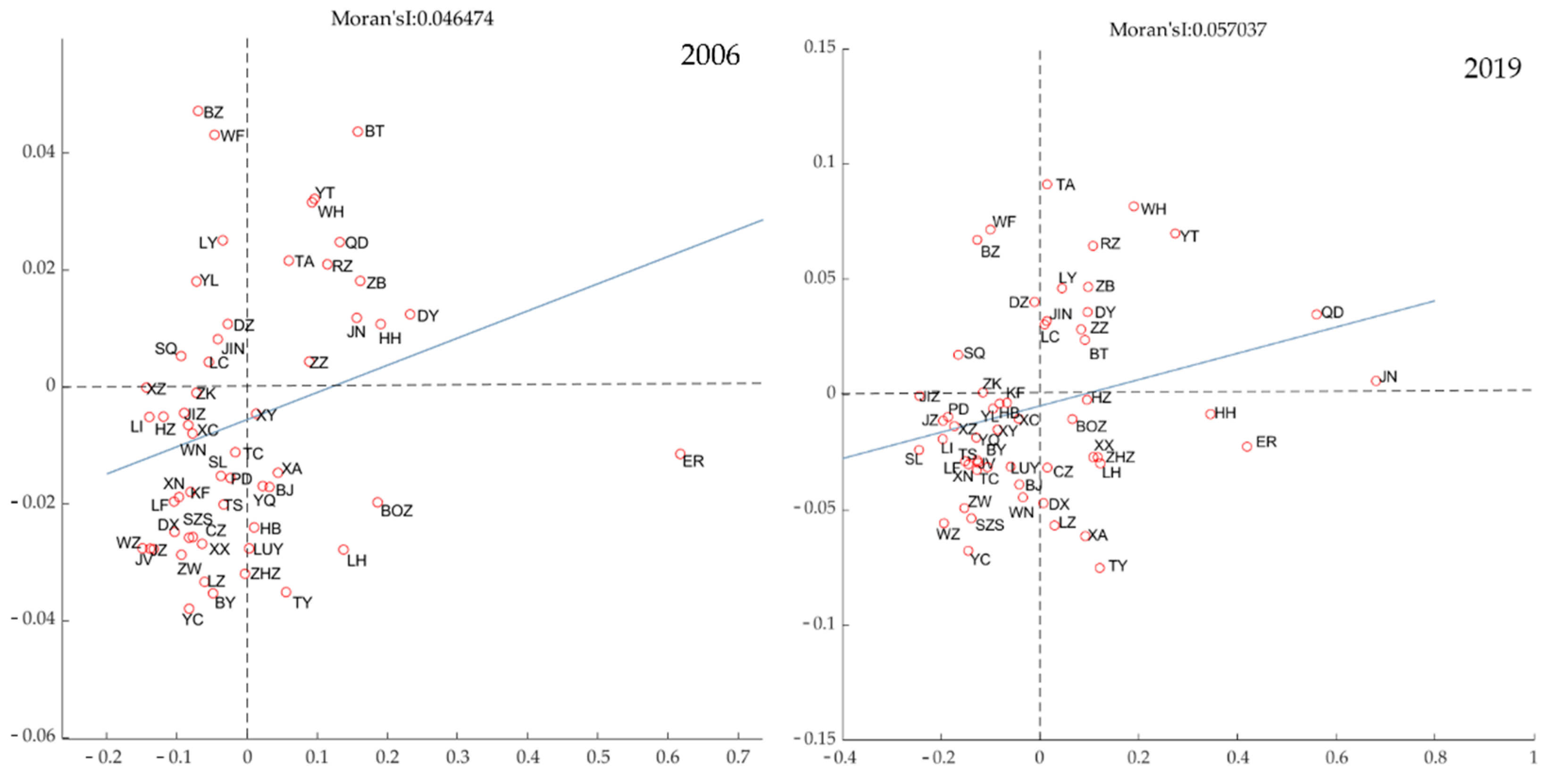
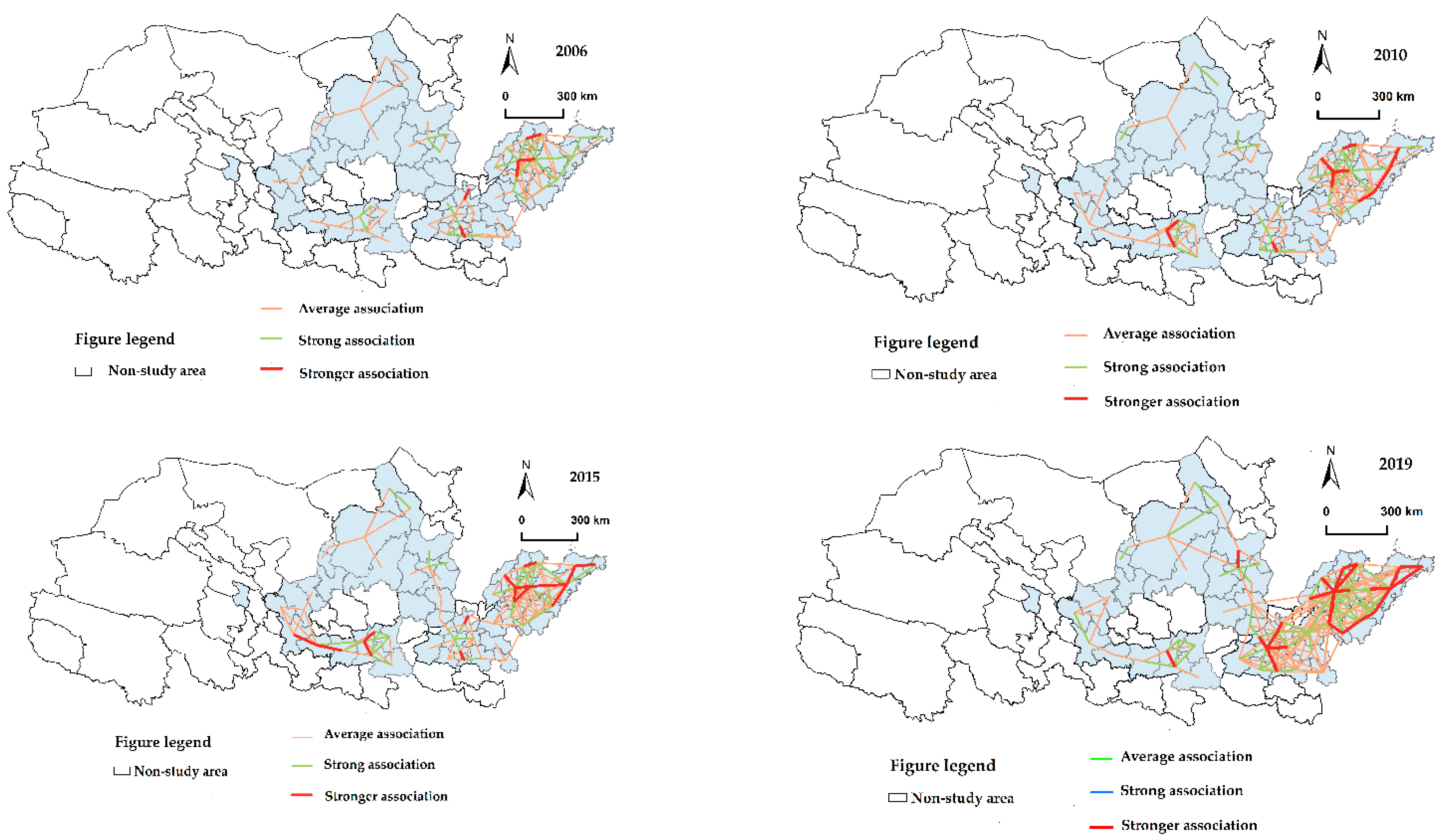
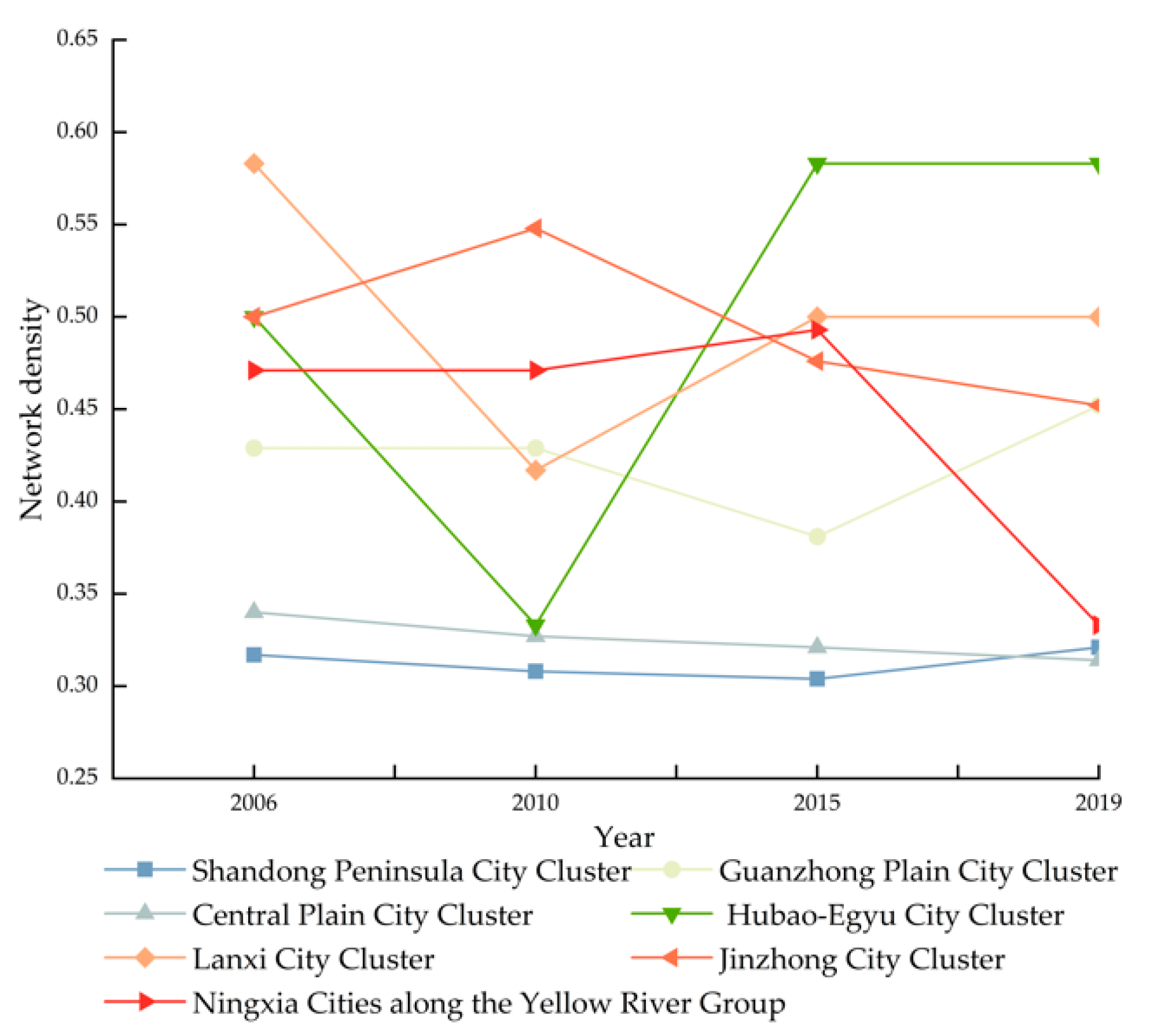
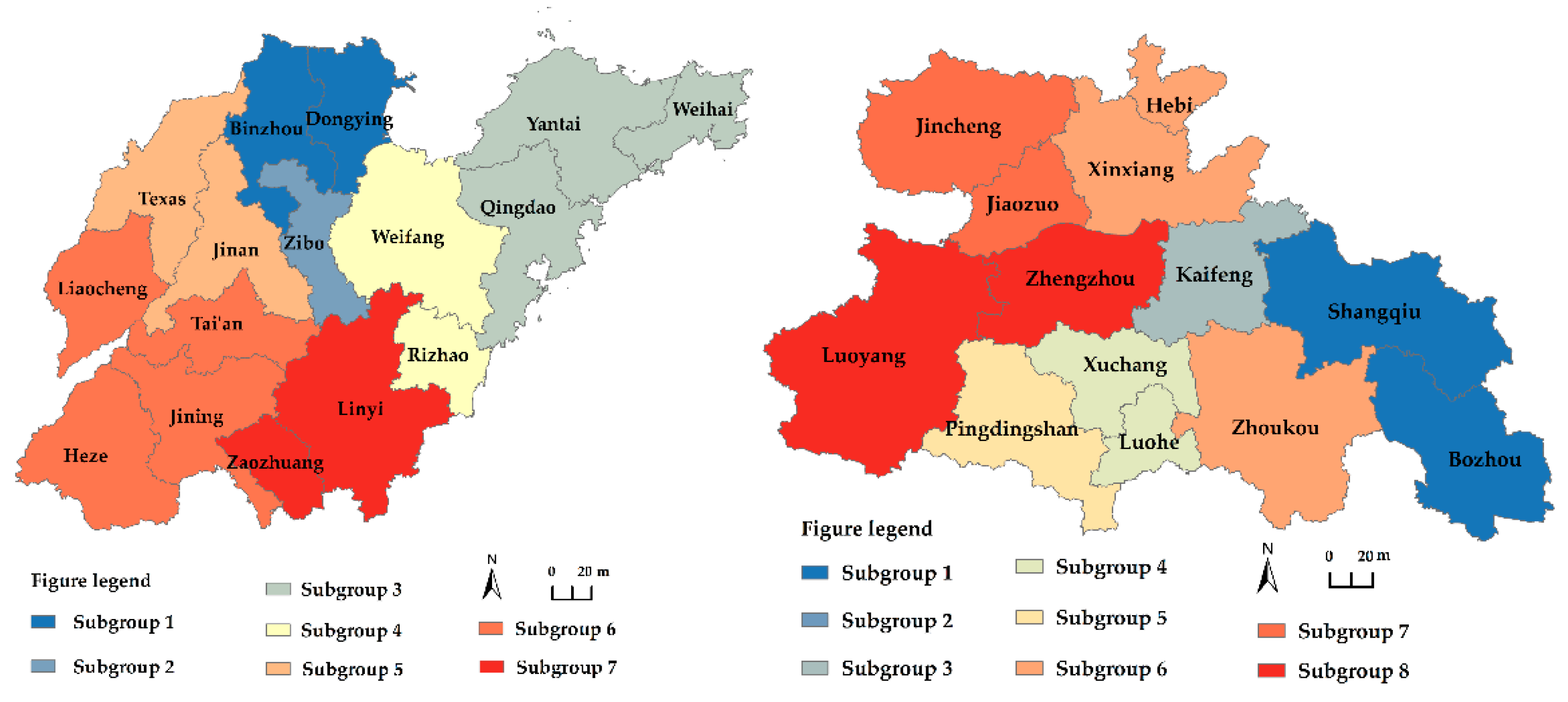
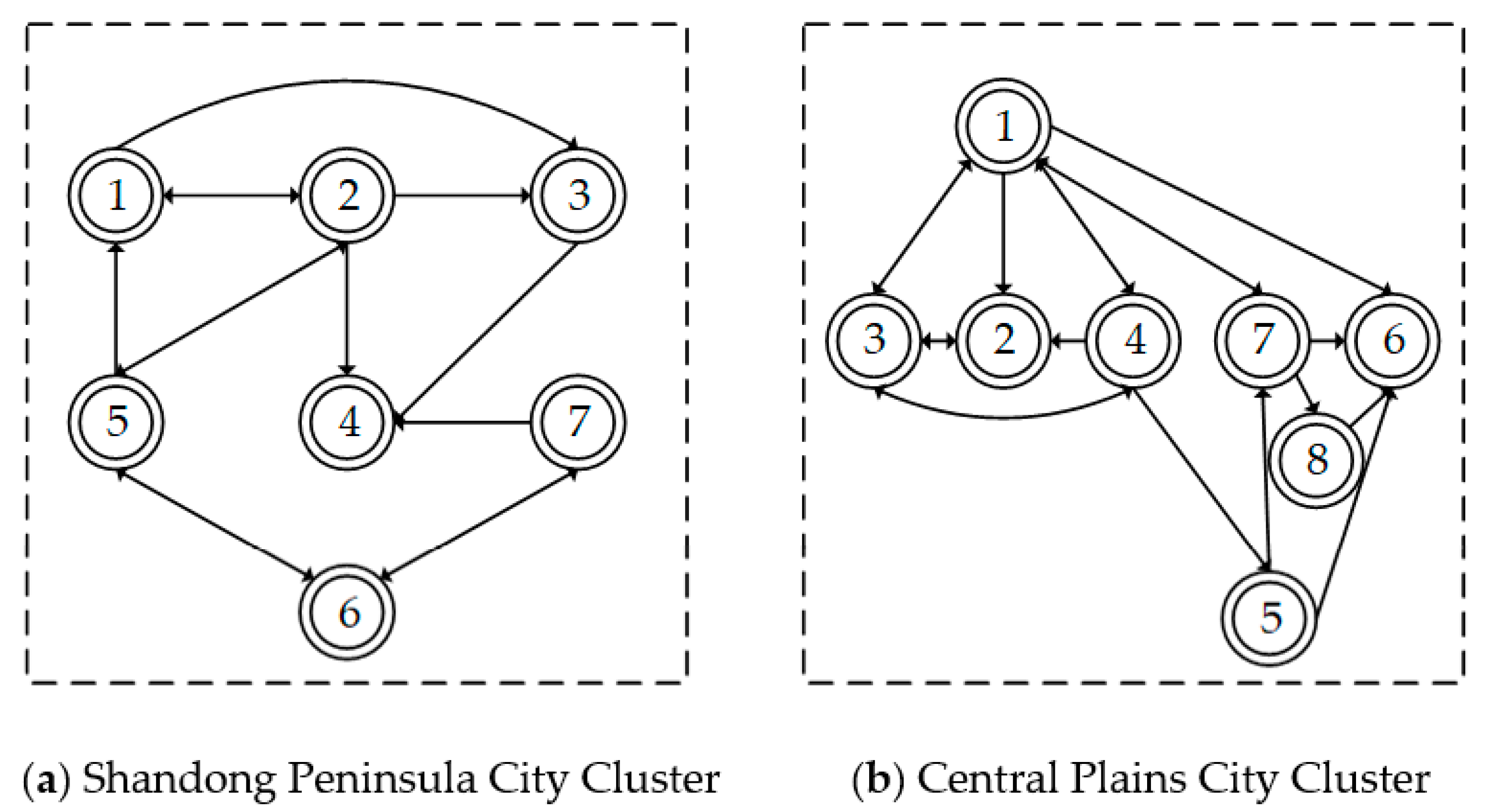
| First-Level Indicators | Second-Level Indicators | Third-Level Indicators |
|---|---|---|
| Inputs | Labor | The labor factor is the total number of employed persons in the municipal area. |
| Capital | The capital stock is expressed in terms of capital stock [35]. The capital stock is calculated using the perpetual inventory method with the formula: where: denotes the capital stock of city in year (billion yuan); denotes the capital depreciation rate, and this paper follows the estimation of Zhang Jun et al. The depreciation rate is calculated using 9.6%: denotes the capital flow (billion yuan). | |
| Energy | The energy factor is natural gas, liquefied petroleum gas, social electricity, and total heat supply. The energy consumption is converted into standard coal due to the lack of uniform units. The conversion factors are 1.33 kg tec/m3, 1.7143 kg tec/kg, 0.1229 kg tec/(kW-h), and 0.03412 kg tec/(MIL- J) in order to referring to the General Rules for Calculation of Comprehensive Energy Consumption. | |
| Expected outputs | GDP | The GDP was deflated using 2006 as the base period. |
| Unexpected outputs | Carbon dioxide emission | The total carbon emissions were calculated according to Wu et al. [36]. |
| Indicators | City Cluster | 2006 | 2010 | 2015 | 2019 |
|---|---|---|---|---|---|
| Point to center potential (%) | Shandong Peninsula city cluster | 30.22 | 31.11 | 38.67 | 29.78 |
| Central Plain city cluster | 35.42 | 36.81 | 37.50 | 38.19 | |
| Guanzhong Plain city cluster | 66.67 | 66.67 | 52.78 | 63.89 | |
| Hubao-egyu city cluster | 66.67 | 5.710 | 55.56 | 55.56 | |
| Lanxi city cluster | 55.56 | 77.78 | 66.67 | 66.67 | |
| Jinzhong city cluster | 58.33 | 52.78 | 22.22 | 25.00 | |
| Ningxia cities along the Yellow River Group | 6.820 | 5.710 | 6.820 | 5.170 | |
| Point out the central potential (%) | Shandong Peninsula city cluster | 8.89 | 16.89 | 10.22 | 15.56 |
| Central Plain city cluster | 26.39 | 18.75 | 19.44 | 29.17 | |
| Guanzhong Plain city cluster | 8.330 | 8.330 | 33.33 | 25.00 | |
| Hubao-egyu city cluster | 22.22 | 5.710 | 11.11 | 11.11 | |
| Lanxi city cluster | 55.56 | 33.33 | 22.22 | 22.22 | |
| Jinzhong city cluster | 19.44 | 13.89 | 22.22 | 5.560 | |
| Ningxia cities along the Yellow River Group | 6.820 | 5.710 | 6.820 | 5.170 |
| Year | Sorting | Shandong Peninsula City Cluster | Central Plain City Cluster | Lanxi City Cluster | |||||||||
|---|---|---|---|---|---|---|---|---|---|---|---|---|---|
| Point-In Degree | Score | Point Out the Degree of Deviation | Score | Point-In Degree | Score | Point Out the Degree of Deviation | Score | Point-In Degree | Score | Point Out the Degree of Deviation | Score | ||
| 2006 | 1 | Taian | 9.0 | Taian | 6.0 | Luohe | 8.0 | Kaifeng | 7.0 | Baiyin | 3.0 | Xining | 3.0 |
| 2 | Zibo | 8.0 | Zibo | 6.0 | Kaifeng | 7.0 | Zhengzhou | 6.0 | Dingxi | 3.0 | Lanzhou | 2.0 | |
| 2010 | 1 | Taian | 9.0 | Taian | 7.0 | Xuchang | 8.0 | Kaifeng | 6.0 | Dingxi | 3.0 | Lanzhou | 2.0 |
| 2 | Zibo | 8.0 | Zibo | 6.0 | Luohe | 8.0 | Zhengzhou | 6.0 | Baiyin | 2.0 | Dingxi | 1.0 | |
| 2015 | 1 | Taian | 10.0 | Rizhao | 6.0 | Kaifeng | 8.0 | Luoyang | 6.0 | Dingxi | 3.0 | Lanzhou | 2.0 |
| 2 | Zibo | 8.0 | Zibo | 6.0 | Luohe | 8.0 | Kaifeng | 5.0 | Baiyin | 2.0 | Xining | 2.0 | |
| 2019 | 1 | Taian | 9.0 | Taian | 7.0 | Luohe | 8.0 | Luoyang | 7.0 | Dingxi | 3.0 | Lanzhou | 2.0 |
| 2 | Zibo | 8.0 | Zibo | 7.0 | Xinxiang | 7.0 | Kaifeng | 5.0 | Baiyin | 2.0 | Xining | 2.0 | |
Publisher’s Note: MDPI stays neutral with regard to jurisdictional claims in published maps and institutional affiliations. |
© 2022 by the authors. Licensee MDPI, Basel, Switzerland. This article is an open access article distributed under the terms and conditions of the Creative Commons Attribution (CC BY) license (https://creativecommons.org/licenses/by/4.0/).
Share and Cite
Song, H.; Gu, L.; Li, Y.; Zhang, X.; Song, Y. Research on Carbon Emission Efficiency Space Relations and Network Structure of the Yellow River Basin City Cluster. Int. J. Environ. Res. Public Health 2022, 19, 12235. https://doi.org/10.3390/ijerph191912235
Song H, Gu L, Li Y, Zhang X, Song Y. Research on Carbon Emission Efficiency Space Relations and Network Structure of the Yellow River Basin City Cluster. International Journal of Environmental Research and Public Health. 2022; 19(19):12235. https://doi.org/10.3390/ijerph191912235
Chicago/Turabian StyleSong, Haihong, Liyuan Gu, Yifan Li, Xin Zhang, and Yuan Song. 2022. "Research on Carbon Emission Efficiency Space Relations and Network Structure of the Yellow River Basin City Cluster" International Journal of Environmental Research and Public Health 19, no. 19: 12235. https://doi.org/10.3390/ijerph191912235





